Conducting Polymer Materials for Flexible OPV Applications: Orgacon™ PEDOT : PSS
Luc Vanmaele
Materials Technology Centre, Agfa Materials Agfa-Gevaert NV, Septestraat 27, B-2640 Mortsel, Belgium
Introduction
The ever increasing global demand for energy has created an opportunity for new technologies that are both cost competitive and "green." Organic Photovoltaics (OPVs) represents the newest generation of technologies in solar power generation, offering benefits of low-cost, light weight and highly automated roll-to-roll mass production processes through coating and printing, while providing added features such as flexibility. OPV systems based upon solution processable polymers or small molecules have been intensively investigated over the past decade to expand fundamental understanding and develop technologies needed to lead to commercial successes.
Agfa, leveraging its industrial coating and printing expertise, introduced a portfolio of Orgacon™ products to enable cost-efficient, solution processed OPV manufacturing on flexible or rigid substrates, using printing technologies such as slot die coating, spin coating, inkjet or screen printing1-3. The Orgacon™ products are based on proprietary poly(3,4-ethylenedioxythiophene):poly(4-styrenesulfonate) (PEDOT:PSS) conductive polymers with properties and performance tailored to the desired manufacturing process and application, respectively (Table 1).
PEDOT:PSS is a water dispersible form of the intrinsically conductive PEDOT polymer. Figure 1 shows the polymerization of EDOT monomer in the presence of polystyrene sulfonic acid, resulting in an aqueous PEDOT:PSS dispersion. Relative to other conducting polymers, PEDOT:PSS has a fairly high conductivity and transparency, and is considered to be a promising material for optoelectronic organic devices because it enables cost-effective roll-to-roll mass production and can be applied on flexible substrates.
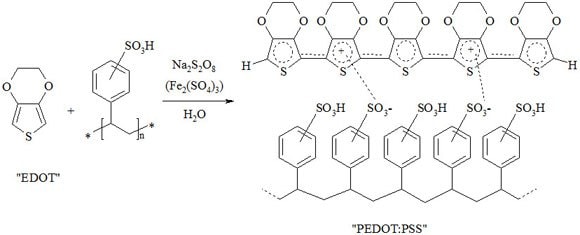
Figure 1.Chemical structure of PEDOT:PSS
Regular and Inverted OPV cells
OPV cells are comprised of layered structures, including anode layer, hole injection layer (HIL), photoactive layer, electron transport layer (ETL), and cathode layer. PEDOT:PSS dispersions find application in OPV devices as HIL materials due to their high work function, good transparency and homogeneous layer formation on indium tin oxide (ITO). ETL materials are typically comprised of electron conductors, such as zinc oxide or titanium dioxide nanoparticles. The geometry of the OPV device determines the layered structure of HIL and ETL materials applied on ITO.
Single cell modules can have two different OPV geometries: regular and inverted (Figure 2). In regular cells typically the anode is ITO and the cathode is a metal with a lower work function than ITO (e.g. aluminum, lithium). In the case of inverted cells, the cathode is ITO and the anode is a metal with a work function higher than ITO (e.g. silver). Both geometries have advantages and drawbacks. Regular OPV cells are easier to scale and require fewer layers; however, inverted OPV cells are more stable and generally show higher efficiencies.
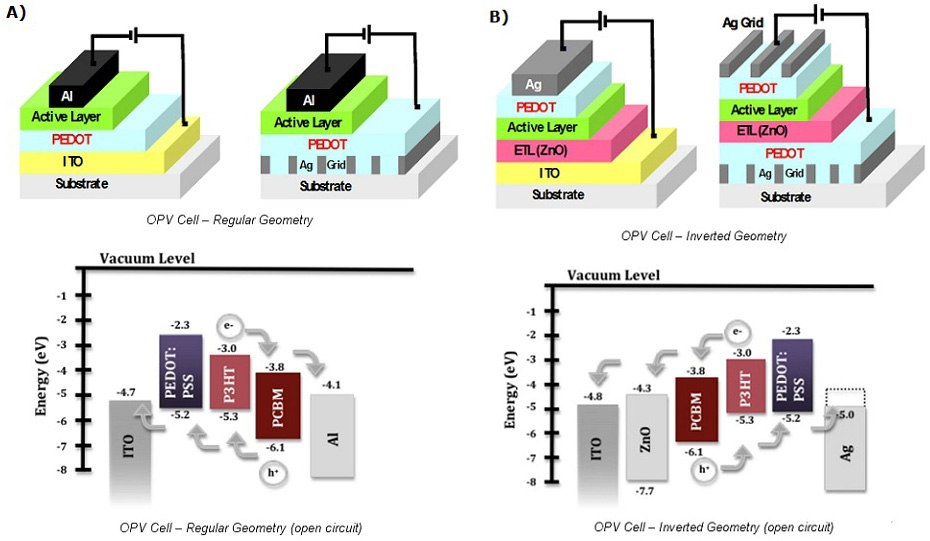
Figure 2.OPV architectures and Corresponding Energy Level Diagrams for A) Regular and B) Inverted Geometries (Adapted from Reference 4)
In the photoactive layer of OPV cells, positive and negative charge carriers are generated by sunlight. These carriers are separated and collected at the cathode and anode in order to complete the circuit. In this process the hole injection layer (HIL) is of crucial importance to efficiently extract positive charges from the photoactive layer by matching energy levels with the anode (Figure 2A). PEDOT:PSS used as a HIL layer (e.g. Orgacon HIL-1005 (Product No. 768642) or IJ-1005 (Product No. 739316)) is essential to provide highly efficient printed solar cells with consistent performance.
Current ITO materials have poor properties such as being stiff/nonflexible, brittle and high cost, which has led to an increased research effort to find alternatives. One opportunity is where the ITO anode/cathode can be replaced with a printed or coated metal grid (e.g. Ag). In regular OPV cells printed metal grids are coated with a PEDOT:PSS hole injection layer (Orgacon HIL-1005 (Product No. 768642) or IJ-1005 (Product No. 739316)), which also acts as a planarization layer. A predicted layer thickness contour plot based on viscosity and rotation speed is given in Figure 3 for spin coating applications.
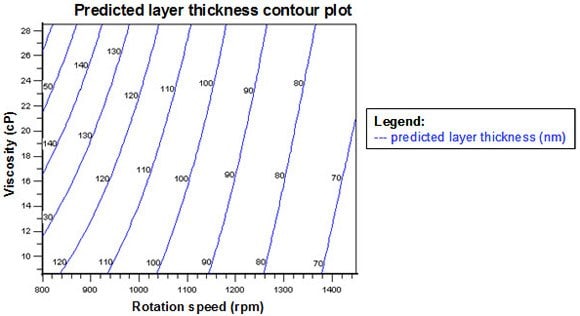
Figure 3.Predicted layer thickness contour plot.
The life time stability performance of such Ag-grid/PEDOT:PSS OPV regular devices is shown in Figure 4. It is clear that metal lid encapsulated devices with a PEDOT:PSS anode (Orgacon HIL-1005 (Product No. 768642)) or with a Ag grid anode coated with PEDOT:PSS (Orgacon HIL-1005 (Product No. 768642)) on a glass substrate have a much better stability than the corresponding device with an ITO anode which was not coated with PEDOT:PSS. Very similar results are obtained with thin film encapsulated Ag-grid/PEDOT devices made on a high end barrier-on-foil substrate.
In an inverted geometry OPV cell, the metal grid can be printed (e.g. screen printing) on top of the PEDOT:PSS hole injection layer. The inverted geometry is currently the preferred architecture enabling the manufacturing of transparent OPV devices by applying both bottom and top transparent (grid) electrodes combined with a thin PEDOT:PSS layer, completely replacing the ITO electrode. OPV cell structures with higher transparency and efficiency are particularly useful for applications such as Building Inte¬grated Photovoltaic (BIPV).
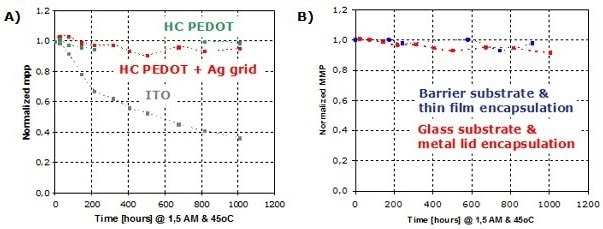
Figure 4.Life time: stability of ITO-less OPV regular devices. Access to glass and/or foil compatible encapsulation. A) Devices (2 cm x 2 cm) made on glass substrate & encapsulated with a metal lid (Al). B) Ag-grid/PEDOT devices (2 cm x 2 cm) made on a high-end barrier substrate followed by thin film encapsulation and on a glass substrate encapsulated with a metal lid (Al).
Note: MPP (MMP) = Maximum Power Point Tested according to AM1.5 (1.5 atmosphere thickness, corresponds to a solar zenith angle of Z=48.2°), HC PEDOT = Orgacon HIL 1005
Tandem Solar Cell
In order to improve the efficiency of OPV systems, new architectures are being developed such as multilayer tandem solar cells, designed to absorb a larger part of the solar light spectrum (Figure 5). In single-junction OPV cells, photons with energies smaller than the bandgap cannot be absorbed and photons with larger energies will lose their excess energy via thermal equilibration. Tandem solar cells can reduce these losses by combining separate sub-cells, which each absorb a different part of the solar spectrum. In a tandem solar architecture, a stack of vapor deposited ZnO or solution-processed ZnO nanoparticles and pH-neutral PEDOT:PSS (Orgacon N-1005 (Product No. 739324)) are used as a recombination layer4,6.
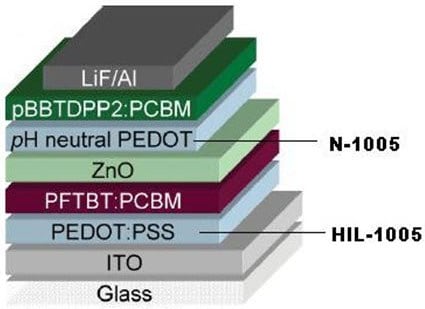
Figure 5.Tandem Solar Cell (Adapted from reference 6)
Summary
Agfa's Orgacon™ OPV product portfolio offers slot die & spin coating formulations as well as ink jet & screen printing inks. Orgacon HIL-1005 (Product No. 768642) & IJ-1005 (Product No. 739316) have been specifically designed to be used as HIL materials and can be applied using slot die coating, spin coating or ink jet printing1. The formulations are optimized for coating on surfaces such as glass, PET, PEN or photoactive materials (e.g. P3HT/PCBM). Surface tension can be further optimized if needed by adding very small amounts of non-ionic surfactants. Alcohols such as isopropyl alcohol (IPA) can also help to optimize the wetting properties, for example onto P3HT/PCBM. Orgacon N-1005 (Product No. 739324) is a pH-neutral PEDOT:PSS formulation for use in tandem OPV cells as recombination layer and can be applied with slot die and spin coating6. Orgacon S305 (Product No. 739340) and Orgacon EL-P 5015 (Product No. 768650) screen printing inks are excellent for applications where an ITO alternative is needed, i.e. by printing on a metal grid to form a highly transparent anode2.
Trademarks
Orgacon is a trademark of Agfa-Gevaert N.V.
Materials
References
To continue reading please sign in or create an account.
Don't Have An Account?